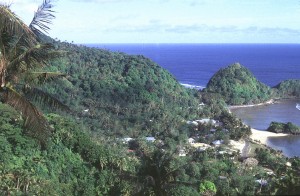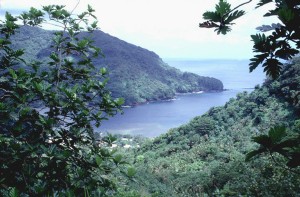 |
 |
View of Amanave Bay, southwest coast of Tutuila, American Samoa. |
Typical deeply dissected north coast area at Fagasa, western Tutuila, American Samoa. |
 |
 |
View of Amanave Bay, southwest coast of Tutuila, American Samoa. |
Typical deeply dissected north coast area at Fagasa, western Tutuila, American Samoa. |
Field Projects in Samoa |
The initiation in 1985 of intensive survey by the University of Oregon for the Historic Preservation Office, American Samoa, marked the beginning of a new and long overdue effort to systematically inventory archaeological sites. This project and others done since provide some of our most detailed evidence of early Samoan settlement distributions. The archaeological site survey and site inventory in selected land areas offered a basis for identifying site distributions and defining occupational density patterns; both are essential for understanding earlier Samoan residential,economic, and political arrangements and for conservation and management plans to be developed by the Historic Preservation Program. Other projects, also done in 1985 on Tutuila, by Helen Leach and Dan Witter onthe Tataga Matau Quarry site, Richard Gould on selected village sites, and by Joe Kennedy on coastal Leone, also contribute significantly to our understanding of facets of early Samoan life. Since that field work was done, Jeff Clark has done considerable research in eastern Tutuilaand his reports provide detailed assessment of early Samoan settlement. He also provides new data on early Samoa ceramics from Aua and new details about inland or ridgetop architectural features. Kirch and Hunt have recovered early pottery and a long sequence from the To'aga Site in the Manu'a Islands. More recently, field work by Epifania Suafo'a, a University of Oregon graduate student, has provided extensive collections of prehistoric pottery from Malaeimi on Tutuila. This research is still underway. The University of Oregon Tutuila Project was designed to carry out intensive survey in selected land areas, such as valley systems and other discrete settlement units. Site mapping,surface artifact collecting, and test excavations were done to more fully document the remains of past occupation within these settlement areas. The main focus of the work has been in western Tutuila, and intensive work was done first in Maloata Valley. |